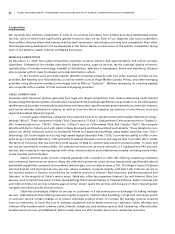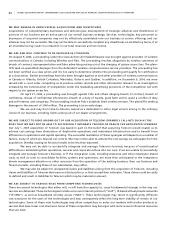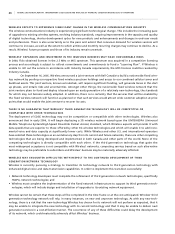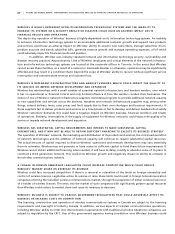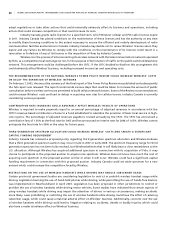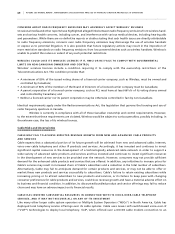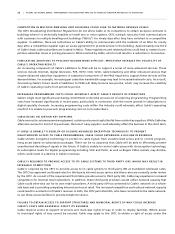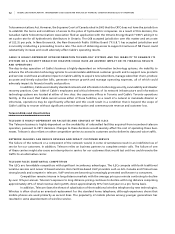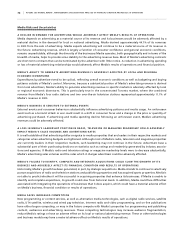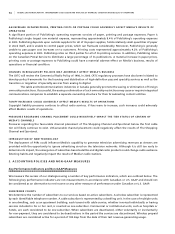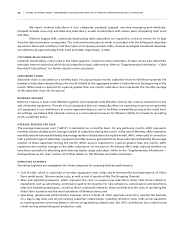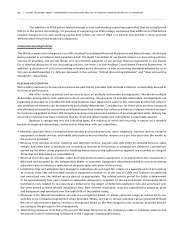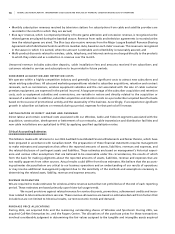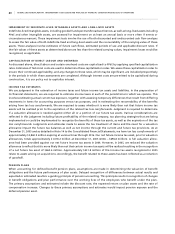Rogers 2005 Annual Report Download - page 74
Download and view the complete annual report
Please find page 74 of the 2005 Rogers annual report below. You can navigate through the pages in the report by either clicking on the pages listed below, or by using the keyword search tool below to find specific information within the annual report.
70 ROGERS 2005 ANNUAL REPORT . MANAGEMENT’S DISCUSSION AND ANALYSIS OF FINANCIAL CONDITION AND RESULTS OF OPERATIONS
MSO’s network that is utilizing industry standard Packet Cable certified components, enables Cable to emulate, with the
exception of network powering, the features, functionality and quality of service of traditional local telephone service.
In connection with the offering of voice-over-cable telephony services, the additional variable additions to
PP&E associated with adding each voice-over-cable telephony service subscriber, which include uninterruptible back-up
powering at the home, is in the range of $300 to $340 per subscriber addition. Cable also cannot predict whether its
voice-over-cable telephony services will be accepted by its customers or whether its voice-over-cable telephony services
will be competitive, from a quality and price perspective, with other telephony services that are and will be available to
its customers. In addition, in deciding to invest in voice-over-cable telephony services, Cable has assumed that Incumbent
Local Exchange Carriers (“ILECs”) will continue to be regulated for voice services and that effective safeguards will be
maintained to restrict the ILECs’ ability to offer these services in an anti-competitive manner. If this assumption proves to
be incorrect, Cable may not recover any or all of its investment in voice-over-cable telephony services, which could have
a material adverse effect on its business and financial condition.
CA B L E’ S B U SI N E SS IS SU B J EC T T O V A R IO U S G OVE R NM E NT A L R E GU L AT I ONS
Cable’s operations are subject to governmental regulations relating to, among other things, licensing, competition,
programming and foreign ownership. A significant percentage of its business activities is regulated by the CRTC under
the Telecommunications Act, the Radiocommunications Act and the Broadcasting Act, and accordingly Cable’s results
of operations are affected by changes in regulations and decisions of the CRTC. Such regulation relates to, among
other things, licensing, competition, the specific cable television programming services that it must distribute, as well
as percentages of foreign ownership and control of cable television licences. In addition, Cable’s CRTC licences must be
renewed from time-to-time and cannot be transferred without regulatory approval. The cable television systems are
also required to obtain certain authorizations and to meet certain technical standards established by Industry Canada,
pursuant to its authority under the Telecommunications Act and the Radiocommunications Act. Changes in regula-
tion by the CRTC, Industry Canada or any other regulatory body could adversely affect Cable’s business and results of
operations. In addition, the costs of providing any of its services may be increased from time-to-time as a result of
compliance with industry or legislative initiatives to address consumer protection concerns or such Internet-related issues
as copyright infringement, unsolicited commercial e-mail, cyber-crime and lawful access.
CH A N GE S T O T H E C R TC ’ S R E GI M E F OR L OC A L T ELE P HO N E C OMP E TI T IO N CO U LD AF F ECT CA B LE ’ S D E LI V ER Y OF
LO C A L T EL E PH O N E S ER V IC E
On April 28, 2005, the CRTC commenced a proceeding to develop the criteria for deregulation of the incumbents’ local
telephone services. A decision is expected in March 2006. On May 12, 2005, the CRTC issued Telecom Decision CRTC 2005-28;
Regulatory framework for voice communication services using Internet Protocol. This decision regulates the local telephone
services of Canada’s incumbent phone companies which use Internet Protocol technology. The decision was in line with
Rogers’ expectations. Regulation includes costing safeguards designed to prevent the incumbent phone companies from
pricing below cost or engaging in anti-competitive conduct. Bell, SaskTel and Telus appealed the decision to the Federal
Cabinet in July 2005. Bell and SaskTel have also filed an application with the CRTC challenging the constitutionality of the
winback rules, another protection for new entrants. In November 2005, Bell and SaskTel filed an application requesting
that the CRTC stay the winback rules pending its final determination. On February 23, 2005, the Federal Government
announced that a Review Panel (“Panel”) would examine Canada’s telecommunications regulatory system. That Panel
was appointed and they have issued a Consultation Paper, received submissions and held public consultations through
the summer and fall. Their report to the Federal Government was expected in December 2005, but has been delayed
until early 2006. If any of these proceedings or processes weakens the regulatory safeguards for new local telephone
entrants, it could have a negative impact on our competitive local telephone service.
CA B L E F AC E S S U BS T AN T IA L CO M PE T IT I O N
Technological, regulatory and public policy trends have resulted in a more competitive environment for cable television
service providers, Internet Service Providers (“ISPs”) and video sales and rental services in Canada. Cable faces competition
from entities utilizing other communications technologies and may face competition from other technologies being devel-
oped or to be developed in the future. The ability to attract and retain customers is also highly-dependent on the quality
and reliability of service provided, as well as execution of business processes in relation to services provided by competitors.


